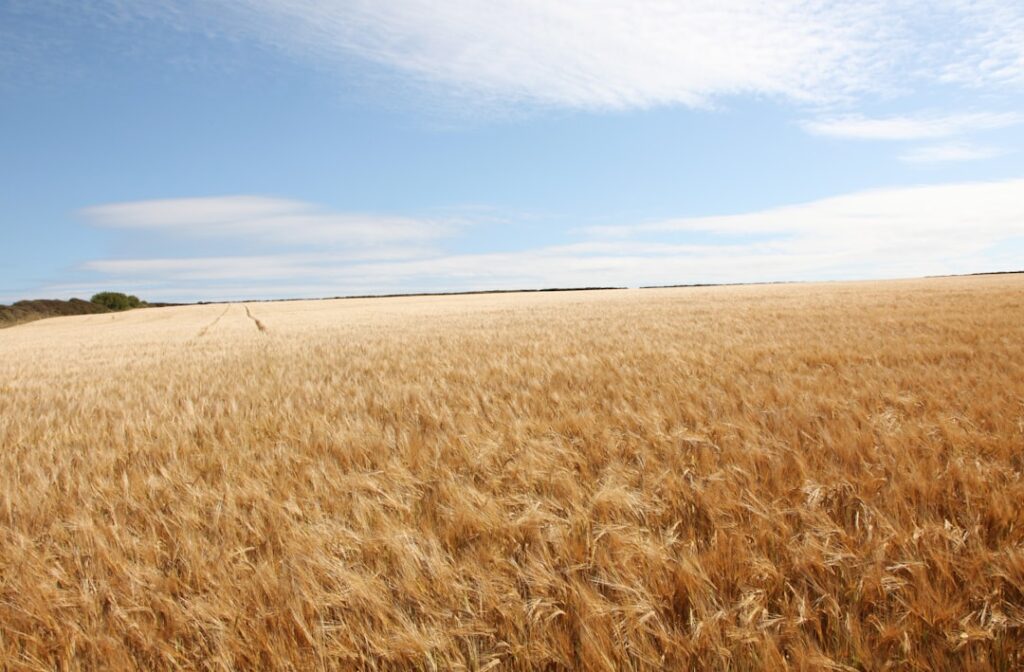The Journey of Wheat to Georgia

Wheat has a storied history that intertwines with the agricultural practices of many cultures, and Georgia is no exception. The origins of wheat in this region can be traced back to ancient times when early civilizations began to cultivate grains for sustenance. Archaeological evidence suggests that wheat was among the first domesticated crops, with its roots extending back to the Fertile Crescent.
As trade routes expanded, wheat found its way into the Caucasus region, including Georgia, where the climate and soil conditions proved favorable for its growth. The introduction of wheat to Georgia was not merely a matter of chance; it was a significant development that shaped the agricultural landscape of the region. The diverse climatic zones of Georgia, ranging from subtropical to temperate, allowed for various wheat varieties to thrive.
This adaptability contributed to the establishment of wheat as a staple crop, influencing local diets and agricultural practices. Over centuries, Georgian farmers honed their techniques, selecting and cultivating specific strains that suited their environmental conditions, thus laying the groundwork for a rich tradition of wheat farming.
Key Takeaways
- Wheat has been cultivated in Georgia for thousands of years, with evidence of its origins dating back to ancient civilizations.
- The history of wheat cultivation in Georgia is rich and diverse, with different varieties being grown and adapted to the local climate and soil conditions.
- Wheat plays a significant role in Georgia’s economy, contributing to both the agricultural sector and the food industry.
- The process of growing wheat in Georgia involves careful planning, planting, and harvesting, with farmers utilizing modern agricultural techniques and equipment.
- The journey from farm to market for wheat in Georgia involves transportation, storage, and distribution to various buyers and consumers, contributing to the state’s food industry.
The History of Wheat Cultivation in Georgia
The history of wheat cultivation in Georgia is marked by resilience and adaptation. During the medieval period, wheat became a central component of the Georgian diet, often featured in traditional dishes such as khachapuri and puri. The cultivation methods evolved over time, influenced by both local practices and external factors such as trade and invasions.
The introduction of new agricultural techniques and tools during the Renaissance period further enhanced wheat production, allowing farmers to increase yields and improve quality. In the 19th century, Georgia experienced significant agricultural reforms that transformed wheat cultivation. The establishment of state-sponsored agricultural schools and research institutions led to advancements in farming techniques and crop management.
These developments were crucial during the Soviet era when Georgia became a key supplier of wheat within the USSR. The focus on large-scale production and collective farming practices during this time had lasting effects on the agricultural landscape, shaping the modern approach to wheat cultivation in the region.
The Role of Wheat in Georgia’s Economy

Wheat plays a pivotal role in Georgia’s economy, serving as both a staple food source and a significant agricultural commodity. The crop contributes substantially to the livelihoods of many rural families, with thousands of farmers engaged in its cultivation across various regions. Wheat production not only supports local economies but also plays a crucial role in food security, ensuring that communities have access to essential nutrition.
In recent years, the economic importance of wheat has been underscored by its role in exports. Georgia has positioned itself as a regional player in the grain market, exporting wheat to neighboring countries and beyond. This has been facilitated by investments in infrastructure and logistics, allowing for more efficient distribution channels.
The government has recognized the potential of wheat as an economic driver and has implemented policies aimed at boosting production and enhancing competitiveness in international markets.
The Process of Growing Wheat in Georgia
| Stage | Timeframe | Activity |
|---|---|---|
| Preparation | Spring | Plowing and tilling the soil |
| Planting | Spring | Sowing wheat seeds |
| Growth | Spring to Summer | Regular watering and fertilizing |
| Harvesting | Summer | Cutting and gathering mature wheat |
Growing wheat in Georgia involves a series of well-defined steps that reflect both traditional practices and modern agricultural techniques. The process begins with soil preparation, which is critical for ensuring optimal growing conditions. Farmers typically conduct soil tests to assess nutrient levels and pH balance, allowing them to make informed decisions about fertilization and amendments.
This initial stage sets the foundation for healthy crop development. Once the soil is prepared, farmers select appropriate wheat varieties based on factors such as climate, soil type, and intended use. Planting usually occurs in late autumn or early spring, depending on the variety chosen.
Farmers employ various planting methods, including broadcasting and drilling, each with its advantages. After planting, careful management practices are essential to ensure healthy growth.
Harvesting typically occurs in late spring or early summer when the grains reach maturity, marking the culmination of months of hard work.
The Journey from Farm to Market: Wheat Distribution in Georgia
The journey of wheat from farm to market in Georgia is a complex process that involves multiple stakeholders and logistical considerations. After harvesting, wheat is transported from farms to local collection points or processing facilities. This initial step is crucial for maintaining grain quality; therefore, farmers often use specialized equipment to minimize damage during transport.
Once at processing facilities, wheat undergoes cleaning and grading to ensure it meets quality standards before being packaged for distribution. The distribution network includes wholesalers, retailers, and export channels that connect Georgian wheat producers with domestic consumers and international markets. The government has invested in improving transportation infrastructure, including roads and railways, which has facilitated more efficient movement of goods.
Additionally, advancements in technology have enabled better tracking and management of supply chains, ensuring that wheat reaches its destination promptly.
The Importance of Wheat in Georgia’s Food Industry
The Cultural Significance of Wheat
Khachapuri, a cheese-filled bread cherished throughout the nation, epitomizes the integral role wheat plays in Georgian cuisine. This beloved dish is a testament to the deep roots of wheat in the country’s gastronomic identity.
Wheat in Modern Food Processing
Beyond its cultural significance, wheat also plays a vital role in modern food processing industries.
The versatility of wheat enables innovation within the food sector, driving the development of new products that appeal to shifting consumer preferences.
Adapting to Evolving Health Trends
As health trends continue to evolve, there is a growing demand for whole grain and specialty flours. In response, producers are adapting their offerings to meet these changing consumer needs, ensuring the continued relevance of wheat in Georgia’s food industry.
Challenges and Innovations in Wheat Production in Georgia
Despite its significance, wheat production in Georgia faces several challenges that threaten sustainability and productivity. Climate change poses a significant risk, with shifting weather patterns leading to unpredictable growing conditions. Droughts or excessive rainfall can adversely affect yields, making it imperative for farmers to adopt more resilient practices.
Additionally, pest infestations and diseases remain persistent threats that require ongoing research and management strategies. In response to these challenges, innovations in agricultural practices are emerging within Georgia’s wheat sector. Farmers are increasingly turning to precision agriculture techniques that utilize technology for better resource management.
This includes using drones for monitoring crop health and employing data analytics for informed decision-making regarding irrigation and fertilization. Furthermore, research institutions are working on developing drought-resistant wheat varieties that can withstand changing climatic conditions while maintaining high yields.
The Future of Wheat in Georgia’s Agriculture
Looking ahead, the future of wheat in Georgia’s agriculture appears promising yet requires strategic planning and adaptation. As global demand for wheat continues to rise due to population growth and changing dietary preferences, Georgia has an opportunity to enhance its production capabilities further. Investments in research and development will be crucial for improving crop resilience and yield efficiency.
Moreover, fostering collaboration between farmers, researchers, and policymakers will be essential for addressing challenges such as climate change and market fluctuations. By embracing sustainable practices and innovative technologies, Georgia can position itself as a leader in wheat production within the region. As consumers increasingly prioritize quality and sustainability in their food choices, Georgian wheat producers have the potential to meet these demands while preserving their rich agricultural heritage for future generations.
FAQs
What is the history of wheat in Georgia?
Wheat has been a staple crop in Georgia for centuries, with evidence of its cultivation dating back to the early Native American tribes. European settlers also brought wheat cultivation to the region during the colonial period.
Where did wheat originate from?
Wheat is believed to have originated in the ancient Near East, in what is now modern-day Turkey and the surrounding regions. It has been cultivated for over 10,000 years.
How far did wheat travel to reach Georgia?
The exact distance that wheat traveled to reach Georgia depends on the specific variety and historical context. However, wheat likely traveled thousands of miles from its origins in the Near East to reach Georgia through trade, migration, and cultivation.
What are the different varieties of wheat that have been cultivated in Georgia?
Several varieties of wheat have been cultivated in Georgia, including hard red winter wheat, soft red winter wheat, and hard red spring wheat. Each variety has its own unique characteristics and uses.
How has wheat cultivation in Georgia evolved over time?
Wheat cultivation in Georgia has evolved with advancements in agricultural technology, changes in climate and environmental conditions, and shifts in consumer demand. Modern wheat cultivation in Georgia often involves the use of advanced machinery, irrigation systems, and sustainable farming practices.








